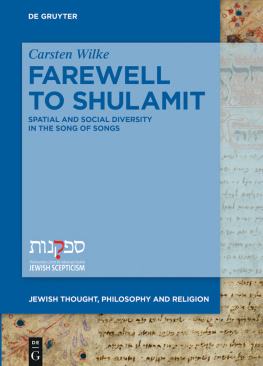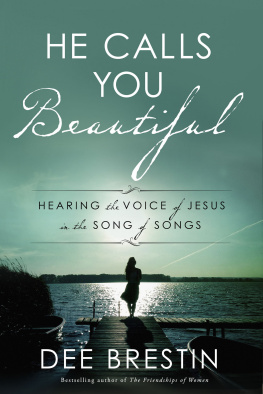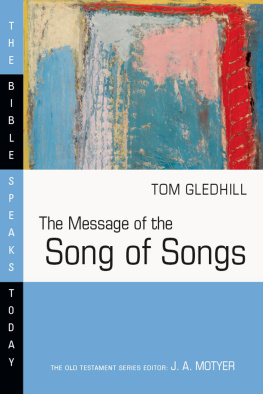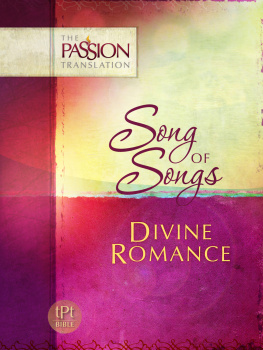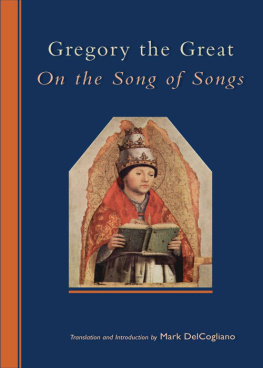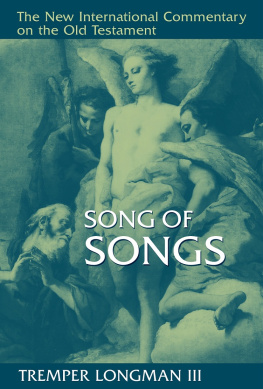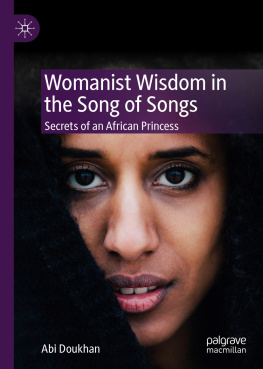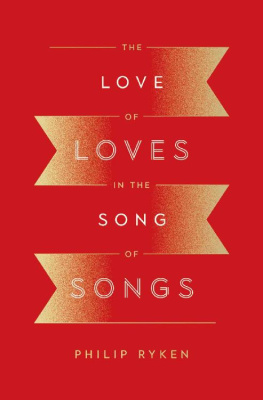Contents
Guide

Carsten Wilke
Farewell to Shulamit
Jewish Thought, Philosophy,and Religion

Edited on behalf ofthe Maimonides Centre for Advanced Studiesby Giuseppe Veltri
Editorial Board
Talya Fishman, Racheli Haliva, Henrik Lagerlund, Reimund Leicht, Stephan Schmid, Carsten Wilke, Irene Zwiep
Volume 2

The series Jewish Thought, Philosophy and Religion is published on behalf of the Maimonides Centre for Advanced Studies

ISBN 978-3-11-050054-7
e-ISBN (PDF) 978-3-11-050088-2
e-ISBN (EPUB) 978-3-11-049887-5
ISSN 2509-7423

This work is licensed under the Creative Commons Attribution-NonCommercial-NoDerivs 3.0 License. For details go to http://creativecommons.org/licenses/by-nc-nd/3.0/.
Library of Congress Cataloging-in-Publication Data
A CIP catalog record for this book has been applied for at the Library of Congress.
Bibliographic information published by the Deutsche Nationalbibliothek
The Deutsche Nationalbibliothek lists this publication in the Deutsche Nationalbibliografie; detailed bibliographic data are available in the Internet at http://dnb.dnb.de.
2017 Walter de Gruyter GmbH, Berlin/Boston
www.degruyter.com

1Space and Gender in the Song of Songs
The idea for the present study originated when I taught an MA seminar (Divine Love in Religious History) in the Religious Studies Program at Central European University in Budapest during the Winter Term of 2015. I would like to thank here the students who participated in that seminar, especially Thomas Bensing, Darja Filippova, Daniel Schmidt, and Hanna Sheliah, for their feedback and engaging discussions. I was able to work on the manuscript during my sabbatical research leave in 20152016 with the support of a senior fellowship grant from the Maimonides Centre for Advanced Studies at the University of Hamburg. I wish to thank Giuseppe Veltri, the Centres founder and director, as well as Guy Bar-Oz, Paolo Bernardini, Seth Bledsoe, Gbor Buzsi, Bill Rebiger, Matthias Riedl, Rabbi Isaac S.D. Sassoon, Ursula Schattner-Rieser, and Charles Snyder for their comments. Finally, I am grateful to Michael Helfield, who has revised the language and style of the present text.
Is Zion a metaphor? Walter Benjamin and Gershom Scholem vigorously debated this question in 1916, the latter answering in the affirmative and the former answering in the negative.
Sojas argument, which tries to avoid the lure of constructivism as well as the fallacy of retrospective determinism, will guide my approach to the issue of biblical philology that I will explore in this paper, namely, the entangled literary treatment of space and gender in the Song of Songs. the blistering sun in the vineyard and the echo of steps in the market at night (3:2) acquire a hauntingly sensorial reality.
In the present study, I will argue that long-standing neglect of the poems spatial diversity has led to oversimplified conclusions about its meaning. And this is particularly regrettable in a text that has been the major model in the West for divine love as well as for much of its profane variant. From antiquity until now, most interpreters have tended to view the poems representation of love as a unified ideal, a concept which they define through the lens of their own predilections for asceticism, monogamy, romance, feminism, environmentalism, frugality, or hedonism. These ideological readings have supported such changing social conventions as affectionate piety, contemplative spirituality, bourgeois marriage ethics, and the ideal of egalitarian love; however, they have invariably been couched in a paradigmatic female character, whose name, Shulamit, adapts an unclear generic term from 7:1 and whose voice is allegedly heard throughout the Song.
A critical approach, however, can and should distinguish between the text and its instrumentalizations by detecting the hermeneutical problems that dogmatic and moralistic interpretations have encountered. For example, the poems most frequently quoted verse, Love is as powerful as death (8:6), is now generally understood as a call for life-long conjugal fidelity because of its liturgical enactment in wedding ceremonies and in popular culture more generally. Yet it is possible to peer through the smoke screen of this institutional reception and to ascertain a textual source that seems content with exalting the impact of emotion in its characteristic social ambivalence.
Opting for a skeptical reading that necessitates very little in the way of interpretive conjectures and textual emendations, I will suppose here that the poems focus on love does not aim to streamline various emotional states toward a common institutional finality, but rather inversely depicts the centrifugal manifestations of a unique existential force. Rather than having a plot that progresses along a linear timeline, the Song has a plan that spreads out in a wide spatial grid. Rather than bundling its meaning in a moral message, the poem disperses it in a prism reflecting four different images of gender relations, the contradictions of which are conspicuously left unreconciled. Rather than blurring and blending social environments, it differentiates between them. In the evocations of elite and popular social life and erotic practice, difference is not denied, nor fought over, nor even made to disappear in an ideal unity: instead, it is maintained from one end to the other, bridged only by the universal experience of desire, pleasure, and reciprocity. In sum, I will suggest here a more adequate mapping and contextualization of the poems manifold erotic attitudes and situations, which can be achieved through an exploration of its discontinuous spaces.
To start with, this point of view requires a new retrospective on the history of the texts exegesis. I do not need to return to the major debates about the content of the text (i. e. divine love, human love, or both?) and about its literary genre (i. e. drama, lyric anthology, or epic narrative?), but I will discuss and analyze previous interpretations of the poem according to the importance they accord to its spaces.
Space as Allegory: Premodern Readings
The incoherent, diatopical structure of the Song could rarely have been a source of embarrassment for exegetes, so long as they treated the landscapes of the poem as metaphors illustrating a unified system of meaning outside the text. In accordance with the rabbinic view, which apparently goes back to Rabbi Akiba (c. 55135 CE), the settings of the poems love dialogue allude to phases of sacred history. According to rabbinic understanding, the deserts, mountains, valleys, vineyards, gardens, towers, and chambers alluded to holy places from the biblical past. For the Church Fathers, they signified a spiritual sanctuary: the mental and emotional states of divine love on the path to salvation. In Grotius reading, all of these landscapes were discrete metaphors referring to the female body.

